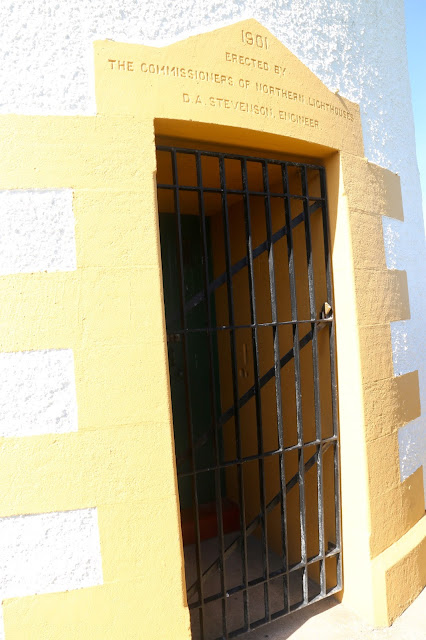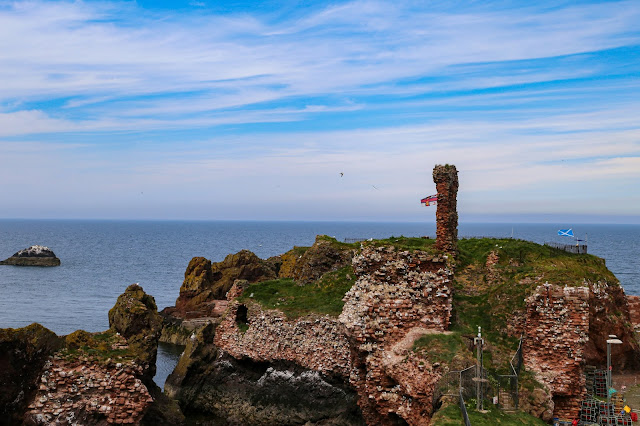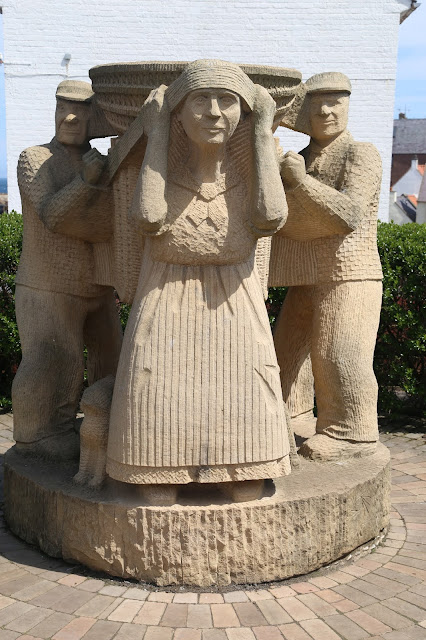This was the third time we have made a booking at the Dunbar Camping and Caravanning Club Site. The first two occasions had to be cancelled because of Covid 19 restrictions and this latest booking, although booked for seven nights had to be curtailed after two nights because of Barbara’s health problems and an urgent need to return to Dumfries Infirmary. During the short period we were there we managed a walk to both the Barns Ness lighthouse and into Dunbar Town.
It is no surprise to us avid pharologists that Barns Ness Lighthouse was constructed by a Stevenson, this time David and Charles Stevenson. The building work was carried out between 1899 and 1901. Constructed from local stone it was manned until 1966 when it was semi-automated and then in 1986 it was completely automated. But by 2005 it was decided that the lighthouse was no longer needed therefore deactivated and put up for sale. The lighthouse keepers’ cottages are now available for holiday letting.
 |
| White Sands Bay. |
The exclusivity of golfers never fails to dismay. To walk from the campsite, you have to walk down to White Sands Bay to pick up the John Muir Way to allow you to walk along the shore to Dunbar. This puts probably an extra hour to the walk just so the golfers are not inconvenienced, it’s claimed it for health and safety reasons but I’m not convinced?
 |
| Dunbar from the coastal path. |
Dunbar is a lovely wee town with its fair share of history and fortunately is know bypassed by the A1. Because of its close proximity to Edinburgh, with a direct railway link to our capital city, it has become a dormitory town with a population of probably 3 to 4 times greater than it was in the 1960’s and with property prices to match.
 |
| The main Harbour. |
The Town still has a working harbour which dates from 1574 with improvements carried out in 1650 by Oliver Cromwell.
 |
| The Dunbar Battery opened after extensive repairs in 2017. |
Like many other Scottish towns Dunbar has had a turbulent history as witnessed by the ruined castle above the harbour. The fortress was attacked by Edward 1 of England in 1295 but valiantly withstood a six week siege. Mary Stuart and the Earl of Bothwell sought refuge there after the murder of David Rizzio in 1566. The castle was demolished in 1567 and the stones were used by Cromwell to improve the harbour.
Dunbar Shore and Harbour Neighbourhood Group commissioned The Creel Loaders by sculptor Gardner Molloy. At the height of the herring trade, woman carried fish in heavy wicker baskets known as creels on their backs from the fishing fleet at Dunbar Harbour to various places around the locality.
The town was the birthplace of the conservationist John Muir (1839-1914) whose achievements are remembered at his birthplace, the John Muir Centre at 126 High Street. There is also a coastal country park named after him.
From the harbour walls can be seen large off shore rock formations that are home to various bird nesting areas as witnessed by the huge deposits of guano.












No comments:
Post a Comment